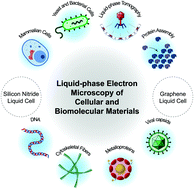Liquid-phase electron microscopy imaging of cellular and biomolecular systems
Abstract
The ongoing development of liquid-phase electron microscopy methods—in which specimens are kept fully solvated in the microscope by encapsulation in transparent, vacuum-tight chambers—is making it possible to investigate a wide variety of nanoscopic dynamic phenomena at the single-particle level, and with nanometer to atomic resolution. As such, there has been growing motivation to make liquid-phase electron microscopy tools applicable not only to inorganic materials, like metals, semiconductors, and ceramics, but also to “soft” materials such as biomolecules and cells, whose nanoscale dynamics and organization are intricately tied to their functionality. Here we review efforts toward making this an experimental reality, summarizing recent liquid-phase electron microscopy studies of whole cells, assembling peptides, and even individual proteins. Successes and challenges are discussed, as well as strategies to maximize the amount of accessible information and minimize the impact of the electron beam. We conclude with an outlook on the potential of liquid-phase electron microscopy to provide new insight into the rich and functional dynamics occurring in biological systems at the microscopic to molecular level.

- This article is part of the themed collection: Journal of Materials Chemistry B Emerging Investigators


 Please wait while we load your content...
Please wait while we load your content...